Society Islands
In Papeete, Tahiti
2 June 2004
At anchor, Maeva Beach, Tahiti
Hello, all!
Today is my 52nd birthday. We are anchored at Maeva Beach, on the western side of Tahiti about 10 miles from downtown Papeete, with a killer view of the island of Moorea from our cockpit. There are a zillion other boats here, but it is very mellow, very pleasant.
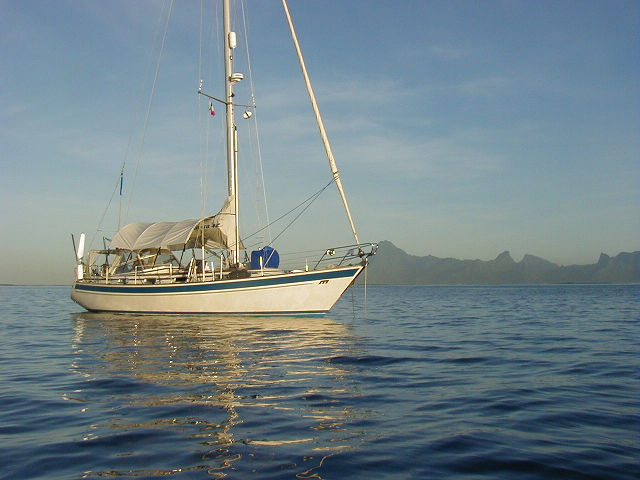
Lee told me yesterday that according to Mayan culture, it is in your 52nd year that you achieve personal wisdom. If that's true, I didn't wake up any more enlightened this morning.
If I had, I would not have gone into downtown Papeete for our first visit. We took "Le Truck" into town, a funky flatbed with seats on it, and looked around. What a shock! Papeete is noisy, polluted, and looks like it got its architectural inspirations from the Soviets. The legendary quay where many of the yachts Med-moor, is right next to a four lane highway clogged with trucks, buses, and cars, all unencumbered by any pollution controls. We got out of there as fast as we could, but had to get our paperwork processed. First the gendarme, then the port captain, then customs. No wonder they were all so grumpy! We will probably go back into Papeete once more to pick up some marine supplies, but will spend the rest of our time in Tahiti in other anchorages. Fortunately, there are many, all much more pleasant than this legendary Polynesian city. I will say, however, that Papeete had some wonderful open air markets where you could find anything you wanted --- quite a trove of riches after a couple of month in the sparsely supplied Marquesas and Tuomotus.
On a different note, something that has impressed me in all the places we have stayed in French Polynesia is the many dedicated men that go out every morning and evening in outrigger canoes. There are scores of them zipping around our anchorage, sometimes with as many as a dozen men (very rarely, a woman or two) paddling like mad. It takes a lot of dedication to pull together such large groups on a regular basis to go out and work hard like that, night after night. Most are in their 20s, but there are a lot of grey hairs as well. Clearly, traditional Polynesian watercraft are enjoying a big revival here!
-tk
Papeete, Day Four
4 June 2004
At anchor, Maeva Beach, Tahiti
Hello, all!
Yesterday we were hanging out at a friend's boat when the gendarmes tooled up in their launch. They said that our friend, as well as us, were anchored out in the channel and that we all needed to move. The channel is marked by a pair of red buoys and it sure looked to me that we were on the correct side, but you don't argue with a gendarme. Then the guy noticed that we were not flying a flag and demanded that we put out our US flag, something that I have recently not been very enthusiastic about doing. To complete our humiliation, our dinghy, tied up to our friend's boat, picked that exact moment to untie itself and begin drifting away. The gendarme noticed and wanted to know whose boat that was. I confessed and was about to dive into the water to go fetch it when, sensing that he'd had enough fun at the expense of a couple of Americans, he offered to take me over to get it.
Actually, it turned out that he did us a big favor. We reanchored on the other side of the channel, closer to the reef, where there is much less boat traffic and the view is breathtaking!
These reef anchorages are a bit disconcerting. There is nothing but water between us and the deep ocean, with the reef, shoaling to perhaps 2-3 feet, in the way. Huge 20' breakers come rolling towards the boat, but crash 100 meters away on the reef, sending just a few harmless ripples across to us.
This morning we went back into downtown Papeete to get some butane and charts. We've had a tough time getting our propane bottles filled because most French Polynesians just swap bottles rather than have them refilled. Plus, our bottles have a US style thread, rather than the local metric thread. We've been trying to find a place to fill them for about a month now without any luck. We heard from a fellow cruiser that "Gaz Tahiti" the distributor for all Polynesia and located near downtown, might be able to fill them, although with butane, not propane.
Rather than take our propane bottles onto "Le Truck," we decided to take the dinghy. Downtown is about 5 miles away, mostly on the lagoon behind the reef. Great fun, zooming along the mostly calm water, around the airport, past various motus, and into the main harbor where we zipped between giant ferries and freighters.
We couldn't find a place to leave our dinghy near Gaz Tahiti, so we parked it about a half mile away and walked the rest of the way. Gaz Tahiti is a huge place, packed with giant tanks, pumps, pipes and lots of big trucks. We walked up to the guard station, our little bottle in hand, and asked whether they could sell us 5 kilos of butane from their vast store. No problem! I swapped my Oregon driver's license for a visitor's pass and wandered into the main office. They were very polite and found a guy to go fill our bottle. He disappeared into a labyrinth of pipes and valves and returned 10 minutes later, our bottle full. We walked back to our dinghy and, butane in hand, planed the rest of the way back, returning in 20 minutes.
Typical cruiser's day!
-tk
Moorea
10 June 2004
At anchor, Baie de Opunohu, Moorea
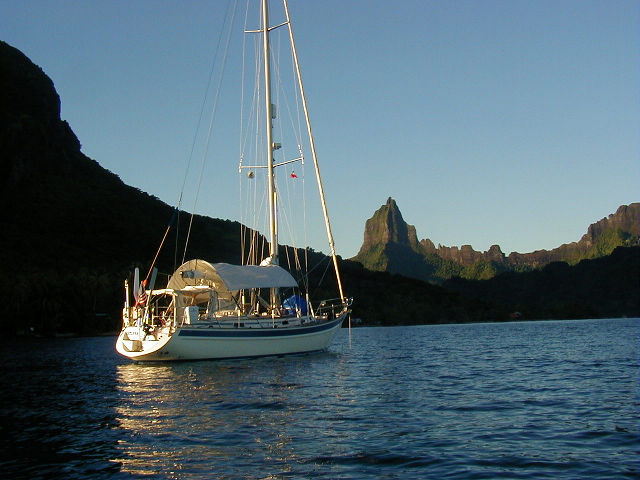
I'd been reading Tony Horwitz's book "Blue Latitudes" about Captain Cook, when friend Chet mentioned in an email that a transit of Venus across the sun was about to happen on 8 June. This is the very event that led the British Admiralty to send Cook out here, now over 235 years ago. I thought, "How cool would it be to go to Point Venus where Cook anchored and watch it!" Unfortunately, Chet pointed out that the transit would start at 7pm and end at 1:30am local time, not the best time to be watching the sun. Oh, well!
After spending a week anchored at Maeva Beach, a few miles from teeming Papeete, Lee and I decided we'd had enough and decamped to nearby Moorea, hoping for a quieter and less polluted environment. Moorea is a stunningly beautiful island of soaring steep and jagged mountains and sheer cliffs, located about 20 miles to the west of Tahiti. It's not the slow-paced and bucolic Marquesas, but neither is it frenetic Papeete. A bedroom community and weekend retreat, it's kind of like Bainbridge Island is to Seattle.
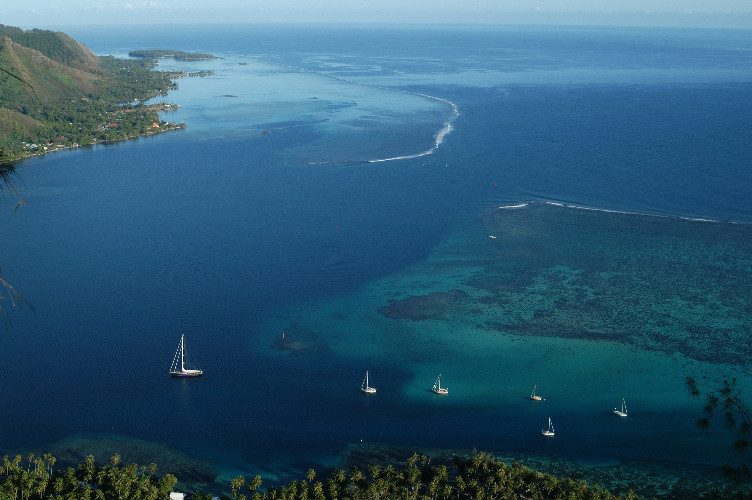
We anchored inside a reef, just inside Baie de Opunohu, one of the two large bays that cut into the north side of the island. From the boat we have views of Mt. Tautuapae, a much photographed volcanic plug with vertical walls, guarded by jagged ridges.
Our second day here we went for a walk in the island interior, but quickly got turned back by the heat and humidity. Noel Coward almost got it right: mad dogs, Englishmen and, it seems, cruisers, are the only ones out in the noonday sun. We are going to try again tomorrow, hoping to hit the beach at 7am.
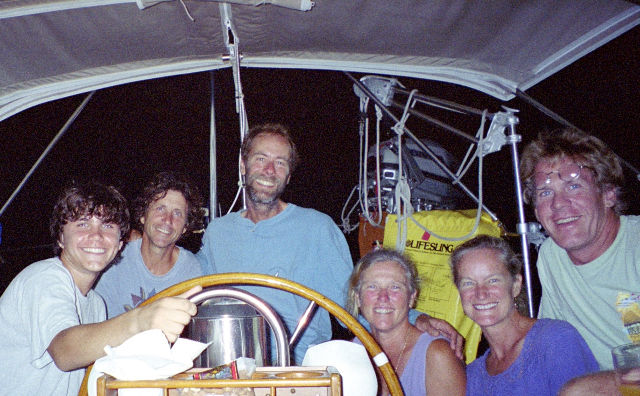
Instead, we went snorkeling on the nearby reef. The water here is very clear, but not extraordinarily so as the Tuomotus. The difference is the nearby landmass. In the Tuomotus, there is nothing but fringing reefs --- the original volcanoes have long since eroded, hence there is no sedimentation. By contrast, Moorea is half-eroded. The water is clear, but the nearby streams carry just enough sediment load to mar the underwater view.
In any case, we were just getting into it when Lee spotted a large shark of unknown kind. I heard an underwater scream and felt her frantically grab my hand. I didn't see the shark, but she wanted to head back to the dinghy. In the past, Lee has had trouble getting out of the water and into the dinghy, a maneuver that requires upper body strength, plus a powerful well-timed kick with the legs. I never saw her do it so smoothly. She launched right out of the water and, like a penguin landing on an ice flow, neatly cleared the gunwale and landed safely in the bottom of the dinghy.
We're going to try again tomorrow from the safety of the beach.
-tk
The Bora Bora Yacht Club
2 July 2004
At anchor, Bora Bora Yacht Club
Sorry for such a long hiatus between logs, but my sister's family has been visiting for the last two weeks and, well, frankly I'd rather spend time with them than perched in front of a computer, writing logs.
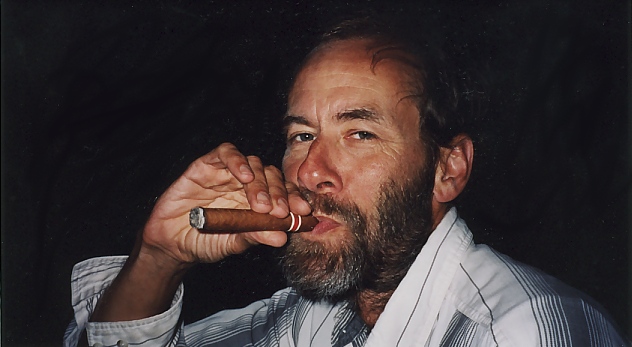
They boarded in Papeete, Tahiti, and just left from fabled Bora Bora, a voyage of about 200 nm. Along the way, the boys and I got our SCUBA certification (or, in my case, "regot" it after a lapse of 20+ years) on the island of Huahine. We really liked this island because it is much less touristy than the other Society Islands, although it does not have the lofty, jagged peaks of some of the other islands.
Once we were certified, we went on to Raiatea, probably my favorite as it has a nice blend of innocence, yet beauty. The boys and I went for a dive on an old, sunken sailing ship, the NANBY, lost in the year 1900 and now lying on its side outside the town of Uturoa. It is in very good condition, its metal bottom still sound enough to hold air from exhaled SCUBA divers. It's in water that ranges from 50 to 90 feet. I had images of something more open and was amazed when our guide led us through a narrow slot between timbers and into the interior. We swam through the hold, flashlights in hand, the only exit to our side through the old ceiling timbers. I managed to get my initial panic of claustrophobia under control and then enjoyed myself. In retrospect, we were all amazed that such an advanced dive would be even considered after only five dives. And, we never signed a release. Clearly, the lawyering vanguards haven't made it to French Polynesia and, frankly, it's refreshing!
Afterwards, we continued on to Bora Bora, anchoring off the "Bora Bora Yacht Club", famous amongst cruisers for its thatched roofs, drinks, and laid back mien. It is exactly as I envisioned it!
Unfortunately, the rest of Bora Bora has suffered from rampant luxury resortitis. Every stretch of the island, every motu, and every bit of the surrounding atoll more than a couple feet above sea level has a high end resort on it, charging from $300 to $1000 per night. Plus, there is an endless stream of big cruise liners coming and going. It's not as tacky as, say, Cancun as all the resorts are low-rise affairs made out of native materials but, collectively, it is overwhelming. The lagoon and reef are being loved to death --- jetskis, fishing, shark feeding, all have taken their toll.
On Sunday our very good friends Art and Celeste arrive from swinging Vermont --- quite a transition they are going to make!
-tk
Bora Bora Yacht Club, Day Nine
8 July 2004
Bora Bora Yacht Club
We have now been moored off the Yacht Club for eight nights and nine days. We stayed for the first few days, until friends Art and Celeste arrived. Unfortunately, they missed their flight in Chicago, so they were a day late. Of course, we didn't know this until after we had gone into town, expecting to meet them at the airport ferry. When they didn't show, I radioed friends back in the anchorage to see if they had somehow slipped past us and were waiting at the Bora Bora Yacht Club. The exchange with Ed on DOODLE BUG (who has a clipped British accent) went something like this:
"DOODLE BUG, do you see a couple of people on the dock at the Yacht Club?"
"No. Wait, yes! There are two people with luggage at the dock!"
"Does the guy look like Fidel Castro?"
(long pause)
"I can't tell. He has his back to me."
"Well, is he balding?"
(another long pause)
"Negative. He has hair! He has hair!"
"False alarm. It's not them."
When they finally arrived, their luggage did not, so we waited another couple of nights for that. Then the weather turned very blustery and rainy, not ideal conditions for making the windward passage to Raiatea, so we have waited that out as well. We hope to finally make our break tomorrow. The winds are supposed to be slightly less strong (but still on the nose). We've decided not to even listen to the weather report in the morning, lest it lessen our resolve!
So, in the meantime, we have been biding our time diving, walking, visiting old friends and making new friends.
-tk
Huahine, Part Deux
13 July 2004
At anchor, village of Fare, island of Huahine
We finally escaped from Bora Bora on Friday, 9 July, and went to Raiatea. We spent a day in the town Uturoa, then went back to Baie de Faaroa, this time to take the dinghy up the freshwater river at the head of the bay, which had been highly recommended by friends Sam and Peter on LILLIAN B.
It's a great trip! Freshwater streams and rivers are rare in Polynesia and this one extends for over two miles up a river valley, twisting and turning through the jungle, like a Disney ride. We motored for a while, then ended up rowing most of the way, pushing vines and branches out of the way to go deeper, deeper, into the island, the stream seldom more than 10m wide. There were beautiful overhanging flowers and trees most of the way.
We had heard that a "botanical garden" existed somewhere along the stream, so on the way back we guessed that a rather high quality dock we had passed must be it. We tied up the dinghy and started walking inland to take a look. After a few minutes of passing through some brush and trees, we encountered a 7 year old girl and her younger brother, cutting up leechee fruits with a knife, washing them off in a stream, and popping them down whole. I asked her in my best French whether this was the botanical garden. She indicated that it was, and then was quick to add that we must pay "at the road." So, we continued up the trail until we finally met a road. But, there was no one to be seen, no sign, no kiosk or building, no indications of any garden, nor any interpretive signs. A bit mystified, we headed back down the trail to be met again by the young girl, who kept insisting that we "payer." I wasn't about to entrust her with any money and I wasn't exactly sure what it was we were paying for, so we kept walking and eventually found ourselves being chased by a seven year old armed with a knife. We jumped into the dinghy and got out of there.
The next day we moved on to one of our favorite islands, Huahine, where we had spent the better part of a week with my sister. We rented a small car and toured the island for a day. It's a wonderful, wonderful place. Very beautiful, but much more traditional than Tahiti, Moorea, or (shudder) Bora Bora. It's the kind of place where you might encounter a group of men playing Ukelele and a washtub bass, just for the fun of it, no tourists around. We greatly enjoyed our time here.
Alas, all good things come to an end and tomorrow we head back to Moorea, then Tahiti, Art and Celeste to fly back, we to put CATS PAW on a Dockwise Transporter bound for Vancouver, BC.
-tk
Moorea, Part Trois
19 July 2004
At anchor, Baie d'Opunohu, Moorea
We are in our final days here in French Polynesia. Friends Art and Celeste left three days ago to return to Vermont. This is now the sixth year in a row that they have spent their summer vacation with us and we have enjoyed every one of them!
And so it is just Lee and me again. We are anchored inside the reef at Baie d'Opunohu on the north side of Moorea, a place that we have anchored twice before. It's a wonderful spot with great views of the mountains of Moorea, and hikes and snorkeling nearby.
Another attraction is the stingrays. The local tour operators take boat loads of tourists out to a nearby sandbank and feed them (the stingrays, not the tourists). It attracts dozens of these critters, who like housecats, will rub up against you trying to get your attention and a free meal. The more brazen will swim right up your chest and get in your face, their ventrally located mouths blindly jawing around, looking for a handout. My intellectual side is appalled by yet another example of man messing around with the dignity of an ecosystem, but my more base side thinks its pretty cool! Yeah, it's so bad we've been out there four times. :-)
This anchoring location is also right offshore from a youth sailing camp. Every morning an armada of perhaps 60 boats --- Optimists, Hobie Cats, and some unidentifiable French boats --- storms off the beach and by our boat. The Optimists are made out of an indestructible aluminum and are sailed by fearless eight year olds who like to use our boat as a mark, so all morning we fend off these friendly young sailors, trying to avoid messing up our gelcoat, but enjoying their enthusiasm. The Hobies are sailed by more serious (and skilled) teenagers who do screaming reaches around their ad hoc race course, one pontoon in the air, the biggest of them out on the trapeze, inches from our transom. It's nerve wracking, but it's hard not to share in their enthusiasm for this sport!
I spent yesterday morning fixing the switch to our anchoring windlass. It refused to raise or lower the anchor. I traced the problem to a bad membrane switch, which is unfortunately not field repairable. So, I jury rigged a new switch out of a piece of wood, six feet of 3-wire cable, two light switches, and some duct tape. Now when you want to raise the anchor, you click the appropriate light switch! It's not pretty and it sure isn't designed for the marine environment, but it will get us home.
We have not had the definitive word from Dockwise yet, but it looks like CATS PAW will get put on their transporter on Saturday, 24 July, bound for Vancouver, thus ending our stay in French Polynesia. We have enjoyed it, but are also ready to head home.
After Friday, please send any email to my Pocketmail email account keffer (at) pocketmail (dot) com.
-tk
Final Days in French Polynesia
30 July 2004
On board SUPER SERVANT 3
Hello, all!
On Tuesday we finally loaded CATS PAW on board SUPER SERVANT 3, the Dockwise transporter, for shipment from Papeete to Vancouver, BC. It's quite an operation! SUPER SERVANT is about 300' long, and is basically a floating dry dock. The ship can sink about 20', putting its decks about 8' under water. Loading is just a simple matter of motoring up on to the sunken decks. Once aboard, they weld and bolt in supporting braces around your boat and then refloat the ship. Your boat ends up high and dry, sitting on the deck. It sure beats the old process of decommissioning the boat!
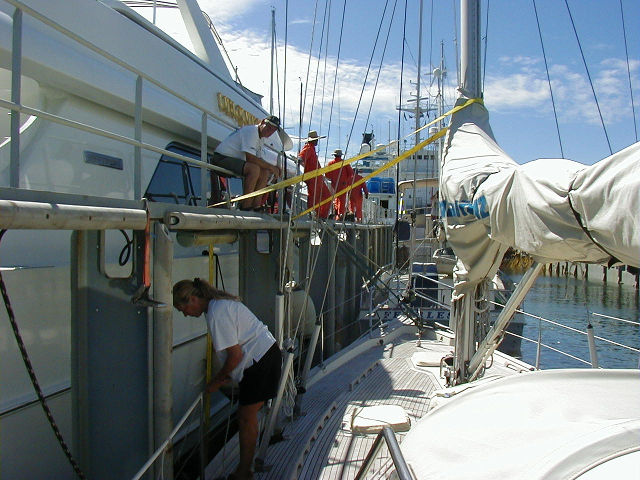
The biggest drama was that it turned out we did not have all the paperwork. The ship's agent asked me for my "Customs Export License." Huh? They had not warned me about this, although I had been to Customs and they stamped the boat's zarpe (exit papers). Furthermore, according to the ship's agent, it could only be obtained from a broker, cost about $400, and the Dockwise transporter could not sail without it. I figured that made it their problem as much as mine, so I dug in my heels, knowing there was no way I could get this paper in the few short hours I had before we flew out of Papeete. Dockwise finally relented, agreeing to get the papers, and I would reimburse them once the boat arrived in Vancouver.
We went into a hotel and, for the first time in five months, truly relaxed --- the boat was somebody else's problem!
Mostly, boating in the S. Pacific has been pleasant and straightforward, but it's not until it's over that your realize what a background stress it can be. There are only a handful of truly secure anchorages in all of French Polynesia, so in the back of your mind, you're always worried about the boat. The trade winds can blow quite hard (30kn+) and an occasional squall can send the winds up into the 50kn range. That, coupled with the exposed nature of the anchorages, often nothing more than the lee of a motu with 3' of freeboard, means you always have to be on guard. It was nice not having to worry about it!
Leaving CATS PAW, I had mixed emotions. On the one hand, I had accomplished what I set out to do. On the other hand, there were still lands to be explored and places to go.
There are things I will not miss about Polynesia, and things that I will miss very much.
What I will not miss is the high prices and bureaucracy. On our last night in Papeete we stayed in a medium level hotel. I was stunned when I checked out to find a charge for 1800 CFP, about $19, for two local calls of five minutes each! I won't miss the $12 watermelons, the $5 scoops of ice cream, $3 bottles of beer, etc.
But, this is small potatoes compared to what I will miss --- the beautiful sunsets, vistas, stunning lagoons, great sailing and, most of all, its kind and gentle people. They are quiet, very respectful, patient, and extraordinarily friendly and giving. Considering their history of exploitation and near extermination, it is remarkable that these people are as generous and patient with us as they are. I'll think of Roger, the Dockwise agent in Papeete, who seldom talking in little more than a whisper, absorbed my paperwork frustrations with aplomb, never losing his cool, kind of cruising along on a higher plane above me. He offered to drive us to our hotel, but on the way said he had to make a stop. What he really had to do was drop in on some friends at the ship quay, to quietly make the rounds, shaking hands, catching up on what was new, then moving on. The whole thing took only 5 minutes, but I thought of the value these small courtesies have to a community. It was the small gesture that a North American would never make --- who can afford 5 minutes in the middle of a workday, with a customer waiting in a car no less? --- yet it makes their culture so much what it is.
While sitting in the Visitor Center in Papeete, watching SUPER SERVANT come into port, a Dockwise customer, fresh off the L.A. plane, came in. His boat was on board SUPER SERVANT. He was still in American mode. Watching his high speed motion, impatience, and just plain rudeness to the Visitor Center's staff, I realized how much of Polynesia had rubbed off on me. I know that when I get home I'll lose much of it, but my hope is that much will stay with me. I also know that when this skipper finally reaches Fiji (his destination), he'll be a changed person too.
-tk